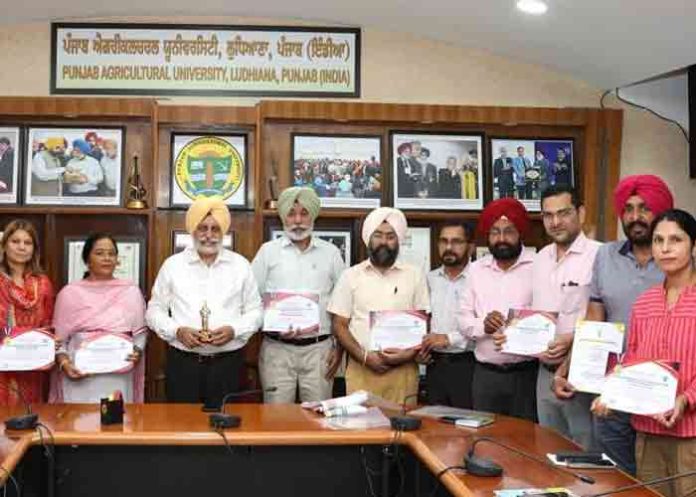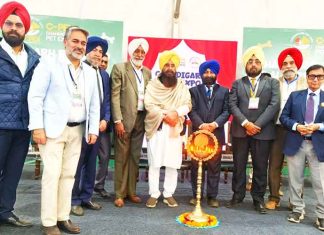Ludhiana, Aug 7 2024 (Yes Punjab News)
In recognition of its outstanding contributions to the development of fodder crop varieties and innovative production and protection technologies, Punjab Agricultural University (PAU) has been honoured with the Certificate of Appreciation as the Best AICRP Forage Crops Centre Award.
The accolade was presented by the Indian Council of Agricultural Research (ICAR) during the National Group Meet held in Ranchi on July 30-31, 2024.
Dr. Satbir Singh Gosal, Vice-Chancellor of PAU, highlighted the university’s remarkable achievement in developing seven forage crop varieties released at the national level in a single year (2023-24).
These include two fodder pearl millet varieties, PCB 166 and PCB 168; one fodder maize variety, J 1009; two oat varieties, OL 1931 (dual purpose) and OL 1949 (multicut); one berseem variety, PC 114 (BL 48); and one perennial lucerne variety, LLC 7.
Providing detailed insights into the new varieties, Dr. Gosal revealed that the berseem variety PC 114 (BL 48) is targeted for the North West zone of India, including Punjab, Haryana, Rajasthan, and Uttarakhand.
BL 48 is a fast-growing variety with a high fodder yield potential of up to 1200 quintals per hectare, outdoing the national check variety Wardan by 7.2 percent.
This variety boasts high crude protein content (18.2%) and excellent in-vitro dry matter digestibility, while also exhibiting moderate resistance to stem rot disease.
The perennial lucerne variety LLC 7 is intended for Punjab, Haryana, and Rajasthan. LLC 7 is a tall variety with a fodder yield potential of 995 quintals per hectare, surpassing national check varieties RL 88 and Anand 2 by 15.8 and 63.6 percent, respectively. This variety also showed a reduced incidence of lucerne weevil.
Dr. Ajmer Singh Dhatt, Director of Research, elaborated on the oat variety OL 1931, identified for the North East zone of India, including Assam, Bihar, Odisha, Jharkhand, and Eastern UP. OL 1931 demonstrates excellent tillering ability and a fodder yield potential of 387 quintals per hectare, outperforming national check varieties UPO 212 and JHO 822 by 9.2 and 10.2 percent, respectively.
This variety is notable for its superior fodder quality characteristics, particularly crude protein yield.
Discussing the oat variety OL 1949, Dr. Gurjit Singh Mangat, Additional Director of Research, informed that it has been identified for the Hill zone of India, encompassing Himachal Pradesh and Jammu & Kashmir. OL 1949 is a tall, multi-tillering variety suitable for multiple cuts.
It exceeded national check varieties UPO 212 and RO 19 for green fodder yield by 8.9 and 4.2 percent, respectively, with a fodder yield potential of 274 quintals per hectare and high crude protein yield.
Dr. V.S. Sohu, Head of the Department of Plant Breeding and Genetics, announced that Dr. Ashlesha received a Certificate of Appreciation for her leadership in Forage Crop Protection and her role in developing three protection technologies. Dr. Meenakshi Goyal, Dr. Rahul Kapoor, and Dr. Davinderpal Singh were also recognized with Certificates of Appreciation for their contributions to the quality profiling of oat and berseem varieties.
The Vice-Chancellor congratulated the Forage and Millet Improvement team of the Department of Plant Breeding and Genetics at PAU Ludhiana, led by Dr. R.S. Sohu.
The team, comprising Dr. Rahul Kapoor, Dr. Ruchika Bhardwaj, Dr. Davinder Pal Singh, Dr. Harpreet Kaur Cheema, Dr. Meenakshi Goyal, Dr. Maninder Kaur, Dr. Ashlesha, Dr. Harpreet Kaur Oberoi, Dr. Ranjit Singh, and Dr. Ravi Prakash Pal, was lauded for their dedication to developing new fodder varieties and advancing production and protection technologies.



































































































